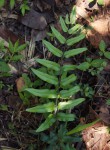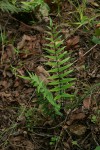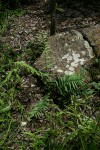Pellaea doniana J.Sm. ex Hook.
Synonyms |
Pteris doniana (J.Sm. ex Hook.) Kuhn |
|---|---|
Common name |
|
Description |
Rhizome creeping to semi-erect, up to 10 mm in diameter; rhizome scales brown, entire, linear, up to 8 mm long, margins paler. Fronds tufted, erect, coriaceous. Stipe dark brown, matt, up to 45 cm long, with a brown scales when young, later becoming glabrous, with scattered scales similar to the rhizome scales near the base. Lamina narrowly oblong to lanceolate in outline, up to 70 cm × 23 cm, imparipinnate with a single pinna on the top resembling the lateral pinnae, lowest pinnae not or slightly reduced, up to 20 pairs of pinnae. Ultimate segments narrowly ovate-lanceolate in outline, up to 10 cm × 2 cm, cordate base articulated to a short petiole, margins minutely crenulate to entire, glabrous on both surfaces, dark green above, paler below, veins free. Rhachis, petiolules and costae similar to the stipe but with short stiff hairs on both surfaces. Sori marginal, continuous; indusium entire, membranous, continuous. |
Notes | At first glance P. doniana might be confused with P. pectiniformis, the latter however has much smaller and more numerous narrowly linear pinnae. |
Derivation | Doniana: named after George Don (1798-1856)who first collected this fern on St. Thomas Island (São Tomé). |
Habitat | Riverine scrub or forest and miombo woodland, mostly shaded. |
Distribution worldwide | |
Distribution in Africa |
Angola, Benin, Burundi, Cameroon, Central African Republic, Chad, Congo, Dem. Republic of Congo, Equatorial Guinea (incl. Bioko), Ghana, Guinea, Ivory Coast, Kenya, Liberia, Malawi, Mali, Mozambique, Nigeria, Rwanda, Senegal, Sierra Leone, Sudan and South Sudan, Tanzania , Togo, Uganda, Zambia, Zimbabwe. |
Growth form |
Lithophytic, terrestrial. |
Literature |
|


